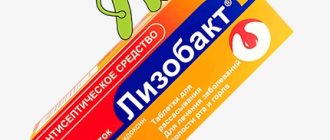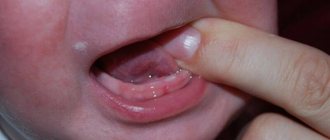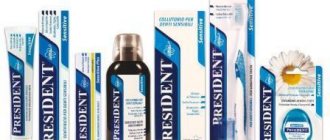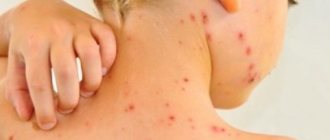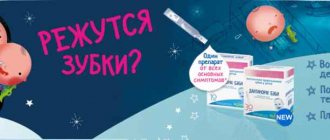Teething
A child's first teeth appear around 6–9 months of age in the first year of life. But the individual characteristics of the body can adjust this schedule, and milk teeth will break through the gums at an earlier period or will begin to bother the baby only closer to the age of one. Do not be alarmed by such changes; the delay in the appearance of teeth is not a pathology. The first tooth is considered the most painful and difficult, but it happens that its appearance may go unnoticed; parents will discover it only at the moment when it begins to knock on the spoon when feeding.
Fever
If the baby’s body temperature has risen, he behaves restlessly and the mother is sure that this is due to teething, then it is worth taking the following actions:
- to make sure there is a connection between tooth eruption and the painful condition, they invite a doctor who will accurately determine the cause of the ailment;
- stop worrying, gain patience and monitor the child’s condition; sometimes the temperature to 38º should not be reduced at all in order to give the body an excellent opportunity to fight the malaise on its own;
- when the temperature rises, the protective substance interferon begins to be produced in the body, and microbes and viruses lose their vital functions due to this, so it is better to be patient and not cool the body;
- since the child’s nervous system needs a night’s rest, the temperature should be lowered in the evening before bed;
- If, while monitoring the baby’s condition, the mother notices convulsions and spasms, then the high temperature should be brought down immediately, for this purpose viburkol is used.
Main causes of illness
The process of the appearance of the first and subsequent teeth is not an easy test for parents , since the baby behaves unusually restlessly, cries, often wakes up at night and reacts sharply to the uncomfortable condition of the gums:
- the whims of a small person are a sign of a very unusual condition for him, when a tooth cuts through the gum, and at the same time, strong heat, itching and unpleasant pain are felt at the site of the wound;
- the risk of infectious diseases and colds increases, since inflammatory processes in the oral cavity reduce the baby’s immunity;
- in the place where a wound appears on the gum, the body produces a large amount of saliva with bactericidal properties, which inhibits inflammation;
- bowel dysfunction, the appearance of dyspepsia may be associated with the penetration of infection through the oral cavity, where the child takes any objects that come across, fingers, in order to instinctively reduce pain symptoms and relieve itching;
- Itchy gums lead to loss of appetite; saliva produced irritates the skin of the cheek, neck and beard.
Gels for teething in children
In addition to the Kholisal discussed above, there are a number of gels that effectively reduce the negative signs of the appearance of the first teeth:
- Kalgel.
Lidocaine, which predominates in the gel, cools the child’s gums, but has a short-term effect, which means the product must be applied frequently.
- Kamistad baby.
Operating through a pair of lidocaine hydrochloride plus chamomile, Kamistad baby quickly relieves pain and calms the baby.
- Baby doctor.
Homeopathic medicine of natural origin is in demand precisely because of its natural composition: plantain, chamomile, echinacea and calendula work well for children who reject chemical medicines.
- Pansoral – first teeth.
Another gel with a “green” composition (saffron, marshmallow, chamomile) is used to relieve pain in children from 4 months. It has no side effects, which means it is safe for babies.
- Dentol baby.
A cheap anesthetic based on benzocaine effectively relieves the pain that accompanies the appearance of children's first teeth.
- Dentinox.
The already proven combination of chamomile and lidocaine hydrochloride, present in Dentinox, is used not only by children, but also by adults (the appearance of wisdom teeth can also be very painful). The gel contains fructose, so it should not be used by people who have problems digesting sugar.
Viburkol drug
It is a homeopathic remedy with a successfully selected complex of constituent substances. The medicine has an antispasmodic, anti-inflammatory, sedative effect, and prevents the occurrence of convulsions. Its action is based on launching protection to restore the impaired functions of the small organism. The components of the drug are selected in such a way that they do not have a destructive effect on the baby’s kidneys and liver.
Viburkol reduces intoxication, and the acute painful stage passes more smoothly, a decrease in temperature leads to a decrease in the painful condition. The German-made drug is available in the form of rectal suppositories for use in the treatment of children with many diseases, one of such cases is teething. This form of release of viburkol is very convenient for treating young children, as they react painfully to swallowing tablets or refuse them altogether.
Instructions for use of the drug
As for treatment directly with Viburkol, we are not talking about complex measures; the difference most often concerns the dosage, which depends on the age of the baby and the change in the number of candles installed per day:
- up to six months, use a suppository to reduce temperature no more than 2 times a day during the treatment of a respiratory infection and for prevention no more than 1 time;
- children older than six months, when treating an infectious disease, increase the number of suppositories per day up to 6 times a day, a lighter state reduces this number to four;
- if the child is more than six months old, and the disease is in the initial stage, then it is enough to put only two rectal suppositories per day;
- during the period of relief after illness, it is recommended to use two suppositories after six months, and at an earlier age one dose of the drug is sufficient;
- To alleviate the condition during teething, 1 candle is placed on a newborn baby and after six months it is used 2 times a day.
Natural components of the medicine
Since the product belongs to the group of homeopathic drugs, it contains natural ingredients:
- chamomile relieves pain during teething, relieves inflammation, and has a sedative effect;
- bittersweet nightshade prevents febrile infections from developing;
- plantain has a beneficial effect on the functioning of the intestines and genitourinary system, which is important in conditions of their improper functioning;
- belladonna relieves inflammation in the respiratory tract, and also treats tonsils;
- meadow lumbago has a positive effect on the functioning of the upper respiratory tract, intestines and stomach, extinguishes nervous mental disorders;
- a substance produced from oyster shells and called Hahnemann's calcium carbonate, has a calming effect and increases protection against colds.
Temperature during teething in children
Hyperthermia syndrome is the baby’s body’s response to changes that occur in his body during teething. The fact is that during this period the immune system of the child’s oral cavity weakens, and the fight against bacteria occurs through fluctuations in body temperature.
Also, around this time, the interaction of the baby’s vital systems of the body is adjusted, including heat exchange.
The normal duration of hyperthermia is up to five days. Usually the fever subsides immediately after the edge of the tooth appears.
If at a temperature of 38 degrees for three days the child is not capricious and shows sufficient activity, then there is no need to worry, the baby’s body itself copes with the threat.
Hyperthermic syndrome, expressed as a temperature above 38 degrees, is already a reason to consult a doctor. Based on the need and condition of the child, the doctor will prescribe antipyretics.
Indications for treatment with viburcol
Therapy with the homeopathic drug Viburkol is used in cases of fever during the period of the appearance of the first and subsequent teeth.
As one of the components of complex treatment, the medicine is used for ARVI infection of the body, the appearance of seizures of unknown etiology, inflammation of the urinary system and intestines, to reduce nervous tension and overexcitation. In some cases, teething coincides with the appearance of individual diseases of this type, sometimes, on the contrary, it provokes symptoms of the above diseases. Modern children often react to chemicals with allergic reactions, so the use of viburkol becomes a real panacea.
Features of the drug use
Viburcol should be used in the evening, before bedtime or in the morning, until the child begins to be actively awake. This is explained by the fact that for the best absorption of the medicine from the intestines, the baby needs to be in a supine position for some time. If you don’t do this, some of the medicine liquefied by the heat will leak out.
Absorption of a substance in the intestine is always more effective than the action of the same component when it enters the stomach and then into the blood, therefore the effect manifests itself faster. Viburkol is often prescribed to children after one year, one suppository once or twice a day , since the painful condition is very individual and sometimes manifests itself at an older age.
Coronavirus infection in children.
Symptoms of coronavirus in children resemble ARVI or are absent altogether. Since a Covid test is not prescribed for a child with a mild illness, there is a high probability that there are many more children with COVID-19 than are recorded.
The SARS-CoV-2 virus enters the child's body through airborne droplets and/or contact (through objects). The first symptoms of Covid in children, as in adults, appear at the end of the incubation period, on average a week after infection. In children with weakened immune systems, the incubation period is reduced to a couple of days. As a rule, children recover on days 7-11 of the disease. Complications after Covid in children are considered to be: pneumonia, bronchitis, bronchiolitis, sinusitis, frontal sinusitis, myocarditis. Possible development of otitis media, hearing loss, neuritis, false croup - laryngeal stenosis. With chronic kidney and liver diseases, there is a possibility of their exacerbation and progression.
A more severe course of Covid is noted in children under one year of age and adolescents over 15 years of age who have chronic pathologies and concomitant diseases, such as:
- cardiovascular diseases;
- oncology;
- immunodeficiency states of various origins;
- lung diseases;
- neuromuscular diseases;
- moderate to severe encephalopathy;
- type 1 diabetes.
In children aged 1 month to one year, the disease is more severe than in newborns. The incidence of severe and critical disease is significantly higher than in other age groups. Symptoms are most often associated with gastrointestinal disorders. Associated signs that may signal coronavirus in infants: the appearance of diarrhea, periodic bouts of vomiting, and a slight increase in body temperature. The stool is liquid, marsh-colored, and may be streaked with blood. Dry cough and difficulty breathing (even shortness of breath). One of the visible symptoms in infants, which indicates a lack of air, is swollen wings of the baby’s nose. Gastrointestinal disorders due to Covid in children under one year of age are often accompanied by abdominal pain. This symptom can be determined independently by certain signs in the child’s behavior:
- presses the legs to the stomach or often jerks them;
- refuses to eat or eats little, and immediately after eating begins severe vomiting;
- frequently wakes up or cannot sleep.
Similar symptoms also occur with functional disorders, for example, infant colic, so a pediatrician must determine the disease.
You should contact your doctor immediately if you experience one or more of the following symptoms:
- the temperature rises sharply (up to 38-39 degrees);
- convulsions begin;
- loose stools occur more often 5-7 times a day, bloody clots are observed in the stool;
- breathing becomes difficult, whistling or wheezing is heard when inhaling or exhaling;
- heart rate increases.
Children aged 1 to 5 years can react to coronavirus infection with a sharp rise in body temperature. Changes in the child’s behavior are possible, such as increased moodiness or tearfulness, lethargy and sudden changes in mood. You can suspect the development of coronavirus in a child based on the following symptoms:
- severe weakness;
- slight cough;
- loss of appetite;
- a sore throat;
- nasal congestion;
- increased body temperature;
- changes in the rhythm and frequency of breathing;
- chest pain;
- dyspnea;
- conjunctivitis;
- gastrointestinal disorder.
The main danger as a complication of Covid in children is multisystem inflammatory syndrome (MSI). This is an excessive immune response of the body to the penetration of the virus. As a rule, MBC develops 1-6 weeks after the acute phase of the disease, even if children have had a mild or asymptomatic form of COVID-19. By this time, in the majority of children who have recovered from coronavirus, PCR tests for covid give a negative result, but antibodies to coronavirus are detected.
As a rule, the first sign of multisystem inflammatory syndrome after Covid in children is a sharp increase in body temperature to high levels (above 38 degrees). Hyperthermia can last for a day or more. A rash may be observed on the body (all over or in certain areas) - macular and/or papular. Characteristic signs of multisystem inflammatory syndrome may include conjunctivitis, scleritis, swollen lymph nodes, and swelling of the palms and feet. One of the common symptoms of MWS is a red or crimson tongue and swollen, bright scarlet lips. The syndrome can lead to damage to the gastrointestinal tract, causing abdominal pain, vomiting, nausea, and diarrhea. The result of MWS can be cardiac, renal, hematological, dermatological disorders, as well as damage to the central nervous system, respiratory failure associated with lung damage.
Most often, coronavirus in children under 6 years of age is asymptomatic. But the asymptomatic course of the disease is not a reason to relax and not monitor the child’s condition. The virus, penetrating the body, causes an immune response and can affect other systems.
Symptoms of Covid in children aged 6 to 12 years are similar to the typical clinical picture of ARVI - sore throat, nasal congestion, cough. A rise in temperature from 37 to 38 degrees occurs more often in them than in younger children. Added to the clinical picture are symptoms in children aged 9 to 12 years, such as aching muscles and joints, conjunctivitis, a purple-red rash, loss of appetite, myalgia (muscle pain) and headache. The course of the disease in children of this age group is more reminiscent of the symptoms of coronavirus in adults.
COVID-19 in adolescents
In children over 12 years of age, the classic clinical picture of coronavirus infection is more common. They may develop an intense dry cough, sore throat, runny nose, loss of smell and taste, and distorted perception of odors. Unlike patients in younger age groups, adolescents may experience malaise with headache and muscle pain. COVID-19 is especially dangerous for those teenagers who have previously been diagnosed with heart disease. Under the influence of the virus, the myocardium is damaged, which leads to serious consequences related to the functioning of the heart.
Diagnosis of coronavirus in children
When the first signs characteristic of COVID-19 appear and/or when a child comes into contact with a person with confirmed coronavirus, you must call a pediatrician. He will examine the child, prescribe a PCR smear for coronavirus and a general blood test. Based on the test result, the pediatrician will give recommendations for caring for the child, prescribe treatment, and, if necessary, refer for consultation to other specialists (pulmonologist, otolaryngologist, ophthalmologist, etc.). If pneumonia is suspected, an X-ray or computed tomography scan of the lungs is performed. To detect respiratory failure, you can use a pulse oximeter, a device that helps measure the concentration of oxygen in arterial blood. Pulse oximeter readings should not be lower than 96 units.
Prevention and treatment of coronavirus in children.
Treatment of Covid in children is no different from symptomatic treatment of other acute respiratory viral infections. There are currently no specific medications for the treatment of COVID-19 in children. Therapy is usually aimed at alleviating the symptoms of the disease and preventing the development of a bacterial infection. Typically, for mild to moderate forms of COVID-19, the pediatrician gives the child the following prescription:
- bed rest, maximum limitation of contacts;
- moist cool indoor air;
- drinking plenty of water;
- washing the nasal mucosa with saline solutions;
- gargling with antiseptics;
- antipyretics for high temperatures (above 38.5 °C);
- enterosorbents for digestive problems;
- antitussives and vasoconstrictors;
- antihistamines.
In case of a complicated course of the disease, antibacterial drugs and drugs that normalize respiratory function are prescribed. If it is necessary to undergo routine vaccination, a child can be vaccinated after Covid two weeks after complete recovery. To minimize the likelihood of a child becoming infected with coronavirus, it is necessary to maintain personal hygiene: wash your hands more often (at least 20 seconds), use antibacterial wipes. As often as possible, treat gadgets, toys, door handles, and work surfaces with antiseptics. It is necessary to ensure that children do not touch their face or eyes with their hands. Maintain water and drinking regime. Pediatricians recommend irrigating the nasal cavity with saline solutions after visiting public places. You should also spend more time in the fresh air and regularly ventilate the room.
